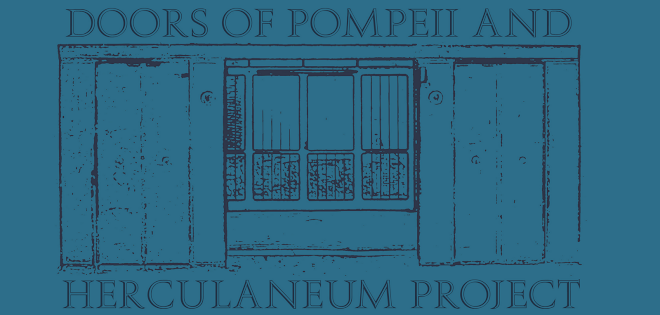As part of the Department of Archaeology postgraduate seminar series, I will be presenting the preliminary results of the Doors of Pompeii and Herculaneum Project and previewing the work scheduled to take place this summer.The talk is scheduled for March 11th at 5 PM in room F1, Old High School. All prospective applicants to the project are welcome to attend.
20 January 2010
Paper: Boundaries and Space in the Campanian House
I will be giving a paper entitled Boundaries and Space in the Campanian House on Saturday, April 10th, 2010 at the City University of New York Graduate Student Conference, Living on the Edge: Perceptions of Liminality in Classical Antiquity. A full conference schedule can be found here.
18 January 2010
Paper: Back in the Frame: Doors in Domestic Space at Pompeii and Herculaneum
I will be presenting a paper entitled Back in the Frame: Doors in Domestic Space at Pompeii and Herculaneum on Saturday, March 27th at the 2010 Roman Archaeology Conference, University of Oxford. This paper will discuss the results of the introductory component of the DOPAH project, a pilot study examining the doorways in the Casa degli Amorini Dorati (VI.16.7), Casa dell’Ara Massima (VI.16.15), Casa del Principe di Napoli (VI.15.8), and Casa di Nettuno e Amfitrite (V.7). A full schedule of the conference is available here.
14 January 2010
Call for volunteers, 2010 field season
The Doors of Pompeii and Herculaneum Project is seeking volunteers for the 2010 field season. The project will last for three weeks, from July 15th-August 3rd, 2010. Volunteers will receive hands-on training in the spatial analytical techniques required for data collection, and instruction on the fundamentals of Roman domestic architecture, with a particular focus on construction methodologies and house layout. The project will also include tours of the Forum, Colosseum, and Palatine Hill in Rome, a day trip to Ostia, and visits to other archaeological sites and museums around the Bay of Naples. Students with an interest in art history, archaeology, classics, or a related field are welcome to apply.
The DOPAHP team will be staying at Camping Zeus (located just outside the Marine Gate at Pompeii) for the majority of the project. The campground has hot showers, laundry facilities, and internet access; shops, restaurants, and a supermarket are a short walk away. Team members will be required to purchase a tent and will be expected to cover their personal expenses, including food, while in Italy. All travel and lodging expenses (including flights from and returning to Edinburgh) will be covered by DOPAHP. As a portion of the project’s costs will be shared by all members of the team, however, a £250 registration fee is also required.
To apply, download an application form. Please email completed forms to doorsofpompeiiandherculaneum@gmail.com byMarch 26, 2010. Now March 12, 2010.
The DOPAHP team will be staying at Camping Zeus (located just outside the Marine Gate at Pompeii) for the majority of the project. The campground has hot showers, laundry facilities, and internet access; shops, restaurants, and a supermarket are a short walk away. Team members will be required to purchase a tent and will be expected to cover their personal expenses, including food, while in Italy. All travel and lodging expenses (including flights from and returning to Edinburgh) will be covered by DOPAHP. As a portion of the project’s costs will be shared by all members of the team, however, a £250 registration fee is also required.
To apply, download an application form. Please email completed forms to doorsofpompeiiandherculaneum@gmail.com by
An introduction to the project
 Over the past three decades, the houses of Pompeii and Herculaneum have frequently been the subject of spatial analytical study. In most cases, an examination of the extant architecture – walls, floors, and other fixed elements – has been the primary method of research. In recent years, however, the study of non-fixed elements, including artefact assemblages and furniture, has led to a reassessment of many widely held theories concerning the use of space within the domus. The Doors of Pompeii and Herculaneum Project seeks to continue this trend by conducting an examination of the doorways in 52 Campanian houses in an effort to reconstruct the size, design, and locking capabilities of internal doors and partitions.
Over the past three decades, the houses of Pompeii and Herculaneum have frequently been the subject of spatial analytical study. In most cases, an examination of the extant architecture – walls, floors, and other fixed elements – has been the primary method of research. In recent years, however, the study of non-fixed elements, including artefact assemblages and furniture, has led to a reassessment of many widely held theories concerning the use of space within the domus. The Doors of Pompeii and Herculaneum Project seeks to continue this trend by conducting an examination of the doorways in 52 Campanian houses in an effort to reconstruct the size, design, and locking capabilities of internal doors and partitions. It has been commonly argued by architects, urban geographers, and archaeologists alike that the identification of boundaries is critical to spatial analyses conducted in domestic contexts. At Pompeii and Herculaneum, this is no less the case. Yet inquiries into the spatial arrangement of houses in these cities have consistently failed to consider the presence of doors, screens, and other physical and visual barriers in the home.
A four-house pilot project was completed in October 2009, resulting in the establishment of an initial database containing the records of 67 doorways. Though some important conclusions have been drawn from this preliminary study, far more data is required to establish reliable typologies for threshold and doorjamb construction, and to better understand the effect that doors had on traffic patterns, viewsheds, and spatial controls within the private home. As a result, a team from the University of Edinburgh will continue the survey in the summer of 2010, conducting architectural analysis on a further 48 houses at Pompeii and Herculaneum.
Subscribe to:
Comments (Atom)



